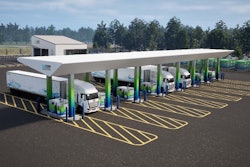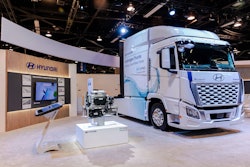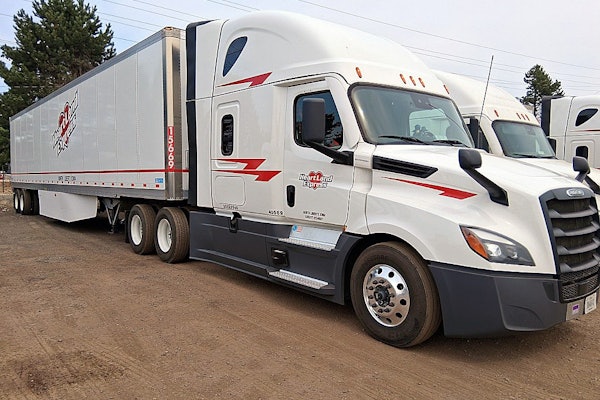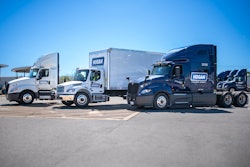CCJ Chief Editor Jason Cannon and Peterbilt Zero Emissions Marketing Manager Patrick Wallace have the first look at the all-new Peterbilt 567EV – the industry's first vocational Battery Electric Vehicle (BEV).
Speaker 1:
Hey everybody, CCJ editor, Jason Cannon here, and join me for a quick up close peak at Peterbilt's. New model 5 67 EV Peterbilt's going after the work truck segment with its newest battery electric model. Keeping a still emerging zero emissions technology in the space where it's found the most success to date, short hauls that return to base without needing to find near non-existent public charging. Peterbilt's. Model 5 67. EV is the first battery electric vocational truck to come to market and serves applications like dump trucks, utility trucks and equipment haulers, vocational applications where range is limited by the nature of the business. Generally 250 miles and less and often include long periods at idle that drive. The accessories are where electrification can shine. The brightest the body uses batteries onboard the truck via the EPTO, either a 25 kilowatts or 150 kilowatts. The electric 5 67 is available in wheelbase of 190 inches or longer in applications up to 82,000 pounds gross.
Combined. The flexibility in wheel bases is in part enabled by an all new PAC RE powertrain. The new E powertrain is the fruit of more than five years of development and testing, and its flexible architecture allows for integration with existing suspensions amid mounted EMO with dual electric motors and integrated three speed transmission delivers. Shifting with no torque interruption. Multiple power options are available up to 605 horsepower and 1850 foot pounds of torque up to five batteries can be specked on the truck, giving it up to 625 usable kilowatt hours. That's up to about 250 miles. The batteries utilize lithium ion phosphate chemistry that offers extended battery life and better long-term performance. LFP batteries retain about 80% of their capacity after a decade of use. Other features of the new powertrain include redesigned electronic accessories and thermal managed batteries for performance. In all weather conditions, the truck is equipped with both AC and DC charging capabilities of up to 350 kilowatts. That's a significant boost from the 150 kilowatt capacity of the current generation powertrain. It also enables a 0% to 80% state of charge in about two hours or less. Here's Patrick to tell us a little bit more about the interior and the exterior of Pete's electric work truck
Speaker 2:
Exterior upgrades. These are kind of like the 5 79 so unique grill. It also has these bars with the blue accents as well. And again, we come to the side of the hood and we have our side panels with blue accents and EV unique pattern right here. And so the big thing about the 5 67 EV is we actually have another battery option, so we can do five batteries as well, going all the way up to 625 usable kilowatt hours. That's very high. And so you can get this in a max range tractor application or a vocational application and you can get all the battery options that you can with the 5 79 as well. We also paid special attention to body integration, so we have two PTO options. We have a 25 kilowatt for PTOs are a little bit smaller, but we also have 150 kilowatt for larger PTOs.
And what's neat about those PTOs is you can actually get dash mounted switches. You can see PTO energy usage in the digital driver display, so it's well integrated so our customers will be able to use it. The PTO you can see is right here. This is actually a new prototype that we're working on that will probably come out in the future, but it's just an example of a PTO that you can put on this truck. So it's all electric, you run high voltage, you run coolant to it, and then you can control that PTO through the digital network, the can network, and it will drive a hydraulic pump. And so this is a conventional dump body. This is a rogue dump body. It's about 15 and a half yards, and so this is optimized for a California market. Another thing I didn't mention before is you can get factory installed lift axles on both these vehicles.
This one has a lift axle. It's got a pusher right here that was factory installed, so this is a great California dump application. You can also get set forward and set back hoods, so anywhere in the country you can optimize a dump truck or aerial or equipment hauler, refuse pickup. We're actually building a rear loader refuse pickup as well. You guys look under the hood, you can actually see the battery down there. It kind of just looks like a black box, but it's got all the batteries. This one does and that other one. This one can go up to 250 miles. So under the hood is where we have a lot of our electronic or electric accessories, right? We have an e HVAC compressor. There's an e HVAC compressor for the cab as well as the battery system. The battery system's thermally controlled, so is the motor.
These are designed to work in Excel in a variety of environments somewhere very hot, somewhere very cold. Another great feature about these vehicles is it has preconditioning. So if you have the truck plugged in, you can actually set your departure time and when you set your departure time, the truck will wake up like an hour before you're set to depart. It'll warm up or it'll cool the batteries and it'll warm up or cool the cab to the last temperature that you set. So when you leave, you're ready to go. It's essentially the same as warming up your engine, right and you're ready to hit the gas and do maximum performance. The last thing I want to talk about here is we're utilizing our CCS one charge ports. You can of course become standard with AC and DC charging AC charging, good for maintaining the batteries or just popping up for servicing. BC charging. We got a lightning fast, 350 kilowatts, so that's a lot better than we had before we had 150 kilowatts. Now if you have the right charger, even with these giant batteries, you can go zero to 80% in as little as two hours. This truck is almost an hour and a half to fully top, up to 80% that lasts 20%. There's a lot of battery balancing, so that's Kylie variable, but you get the idea that you can really charge up quickly.









